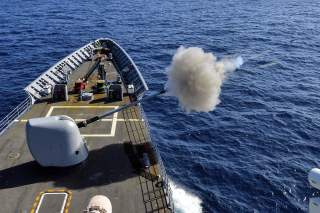The Real U.S.-China War We Should Worry About: A "Range War"
The United States and China have found themselves engaged in a “range war” in the western Pacific, a competition over the distances their missiles and aircraft can attack targets. The fielding of new technology by one side is resulting in responses by the other, with the dimensions of the potentially contested space in the Asia-Pacific region growing with each move in this competition.
We should also expect China to extend the range of its aircraft and cruise missiles. China’s large stealthy J-20 strike fighter, now under development, it thought to have a combat radius of 2,000 kilometers. Should China’s engineers eventually develop a cruise missile like JASSM-ER, a reasonable presumption given their track record, China might again leapfrog ahead with its ability to deliver stealthy strikes against mobile land and naval targets at ranges approaching 3,000 kilometers.
So Who’s Winning the Range War?
The Pentagon’s Air-Sea Battle concept (ASB) has been developed to organize a coordinated response to long range anti-access capabilities China and other potential adversaries are fielding. The concept is thought to rely mostly on direct military action to thwart an adversary’s access-denial military capabilities. In the case of China, critics of ASB assert the concept is incoherent, contains dangerous escalation risks, and recommend instead a distant blockade, implemented by U.S. naval power outside the reach of China’s weapons, as an alternative course of action.
However, the ongoing range war has implications for both concepts. The more China can extend its range past U.S. capabilities, the more challenging the execution of ASB will be. But as China extends its threat against U.S. warships past Indonesia, deep into the Indian Ocean, and into the Central Pacific, implementing a distant blockade will also become more tenuous. Under the range of China’s missiles, the Navy would no longer be able to use Indonesia’s straits as control points for merchant shipping to China. And as the range of China’s missiles increases, it would dramatically increase the length of the blockade perimeter the U.S. would have to patrol, making the blockade potentially more porous.
We can also see that it is increasingly expensive for the U.S. to compete in the range war. With its continental position, China has scores of bases from which its strike aircraft can fly, while the U.S. has only a few in the western Pacific, all of which are vulnerable to missile attack. China’s land-based aircraft will enjoy size, range, and payload advantages compared to smaller carrier-based aircraft. The U.S. Air Force has made its new long-range bomber a top procurement priority, hardly a surprise given the vulnerability of its forward tactical airbases in the Pacific. And although the new bomber will be based on mature technology, the program’s estimated $55 billion tab will not be cheap. But when priced in dollars per pound of payload or targets attacked, that figure will be cheap compared to matching costs (not to mention the technical risk) of the robust version of the Navy’s UCLASS project.
China enjoys its greatest cost advantage with its ability to design and mass produce relatively cheap theater-range ballistic and cruise missile. Perversely, the anachronistic 1987 Intermediate Nuclear Forces (INF) Treaty prohibits the United States (and Russia) from possessing such weapons while China is completely unconstrained. As long as the INF treaty remains in force, the U.S. is denied the cheapest and most straightforward method of maintaining deterrence in the Asia-Pacific region. As a conversation begins on this odd yet increasingly dangerous state of affairs, U.S. military planners will be compelled into expensive work-arounds such as the new bomber and UCLASS.
Finding themselves on the wrong side of the cost inequality, should U.S. policymakers give consideration to abandoning the range war in the Pacific? Surrender is not a responsible option. Japan, India, Indonesia, Vietnam, and all others in the region (except Russia) are not signatories to the INF treaty. The barriers to missile proliferation are relatively low and should the U.S. give up on the region, the incentives by China’s neighbors to acquire cheap yet effective offensive missile inventories would be very high. The resulting multi-sided regional missile race would be an arms control advocate’s worst nightmare. Even worse, that race would occur in the world’s most dynamic economic region, with millions of U.S. jobs at risk from the potential instability. Yet such would be the foreseeable outcome should the U.S. effectively abandon its long-held and highly successful position as the region’s stabilizing force.
Technical and arcane expositions on weapon performance and tactics cause many eyes to glaze over. Yet what seems like trivia will have implications for the plans military staffs assemble, for the advice these staffs provide to policy makers, and for the assumptions and decisions those policymakers make during crises. As we saw a hundred years ago this month, those decisions can quickly sum to a disaster. U.S. policymakers need to reckon with the ongoing range war in the Pacific and consider some new and better ways to stay in the fight.
Robert Haddick is an independent contractor at U.S. Special Operations Command. He writes here in a personal capacity. On September 15, 2014, Naval Institute Press will publish “Fire on the Water: China, America, and the Future of the Pacific,” Haddick’s book on the rise of China’s military power and U.S. strategy in East Asia.


